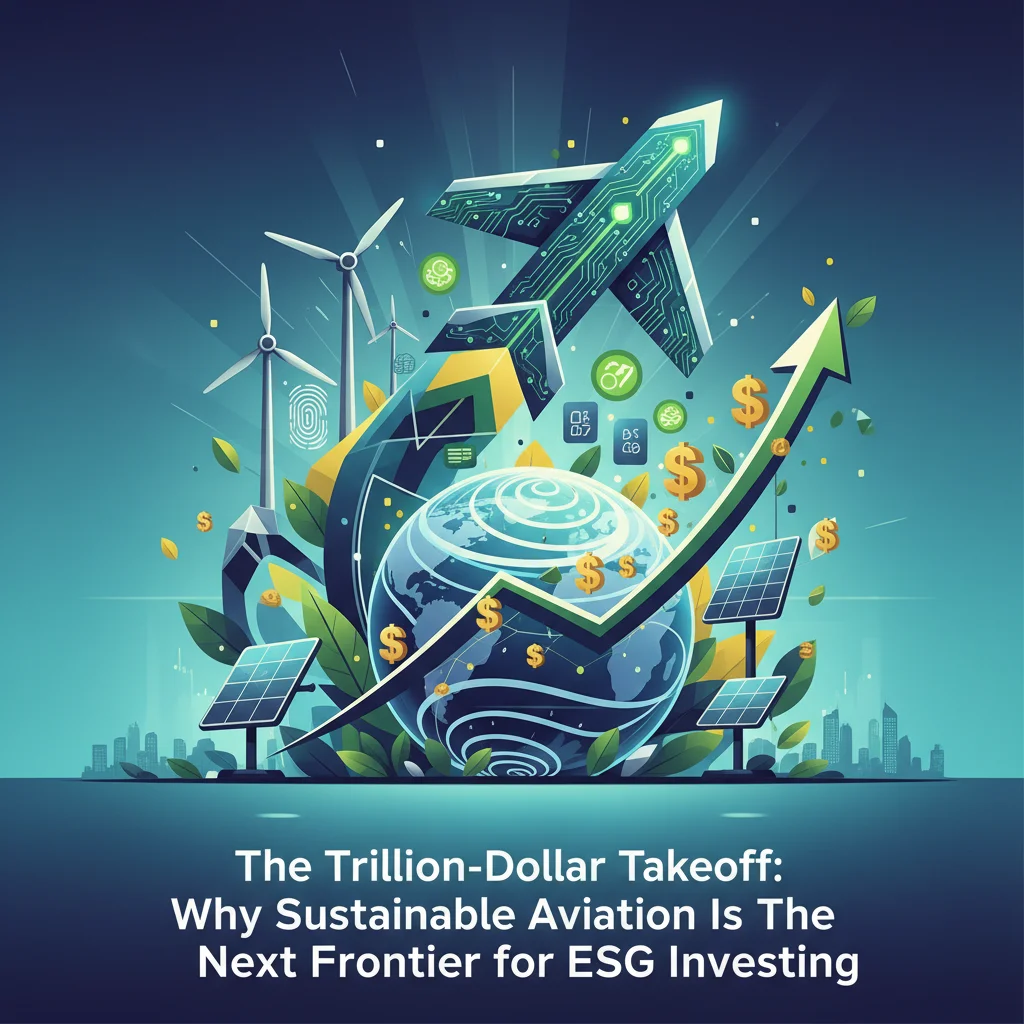
The Trillion-Dollar Takeoff: Why Sustainable Aviation Is The Next Frontier for ESG Investing
We live in an age of paradox. Global connectivity has never been more accessible, with air travel binding our world’s economy, cultures, and communities. Yet, this very freedom comes at a significant environmental cost. The sleek aircraft crisscrossing our skies are a major contributor to global carbon emissions, posing one of the most complex challenges of our time: how do we keep the world connected without compromising its future?
The aviation industry is acutely aware of this dilemma. It’s responsible for approximately 2-3% of global CO2 emissions, a figure that, while seemingly small, represents a “hard-to-abate” sector. Unlike ground transportation, you can’t simply plug a long-haul jet into a charging station. The futuristic solutions of hydrogen-powered or fully electric aircraft are promising, but they remain decades away from commercial viability for the bulk of air travel.
This reality has ignited a fierce race for a solution that can work *today*. As Maria Whittaker of Abra Group highlighted in a recent letter to the Financial Times, the industry faces a “huge challenge” that requires immediate, scalable action (source). The answer, increasingly, is found in Sustainable Aviation Fuel (SAF).
But this isn’t just an environmental story. It’s a story about finance, technology, and a multi-trillion-dollar economic transformation. For savvy investors, finance professionals, and business leaders, understanding the dynamics of SAF is no longer optional—it’s the key to unlocking one of the most significant ESG investing opportunities of the next decade.
Sustainable Aviation Fuel: The Bridge to a Greener Horizon
So, what exactly is Sustainable Aviation Fuel? SAF is a broad category of non-petroleum-based jet fuels that are chemically identical to their conventional counterparts. This means they can be used in existing aircraft and airport infrastructure without any modification—a crucial feature for rapid adoption. The “sustainable” part comes from their source. They can be produced from a variety of renewable feedstocks, including:
- Used cooking oil and animal fats
- Agricultural waste and forestry residues
- Municipal solid waste
- “Power-to-Liquid” or “e-fuels,” created by combining captured carbon with green hydrogen
The environmental payoff is substantial. On a lifecycle basis, SAF can reduce carbon emissions by up to 80% compared to traditional jet fuel. It’s the single most effective tool in the aviation industry’s decarbonization toolkit today. However, it faces one monumental hurdle: cost.
Currently, SAF is anywhere from three to five times more expensive than conventional kerosene. This “green premium” is the primary barrier to widespread adoption. For an industry with famously thin profit margins, asking airlines to voluntarily absorb this cost is a non-starter. This is where financial innovation becomes as critical as chemical engineering.
The table below provides a simplified comparison of conventional fuel versus leading SAF pathways, highlighting the economic and environmental trade-offs that the industry, and its investors, must navigate.
| Fuel Type | Primary Feedstock | Lifecycle CO2 Reduction (vs. Kerosene) | Relative Cost Premium | Scalability Challenge |
|---|---|---|---|---|
| Conventional Jet Fuel (Kerosene) | Crude Oil | 0% (Baseline) | 1x (Baseline) | High (Mature Infrastructure) |
| HEFA-SPK (Biofuel) | Waste Oils, Fats, Greases | 60-85% | 2-4x | Feedstock availability |
| Fischer-Tropsch (FT-SPK) | Biomass, Municipal Waste | 75-95% | 3-6x | High capital cost for facilities |
| Power-to-Liquid (e-fuel) | Green Hydrogen & Captured CO2 | 90-99% | 5-10x+ | Massive renewable energy needed |
As the data shows, the most effective fuels from an emissions perspective are also the most expensive and complex to scale. This is not a problem that can be solved by airlines alone; it requires a market-based solution that connects corporate climate goals with the physical realities of fuel production.
“Book and Claim”: A Fintech Solution for a Physical World Problem
Enter the “book and claim” system—an innovative mechanism that is rapidly gaining traction as a way to bridge the SAF cost and logistics gap. It’s a concept that should feel familiar to anyone versed in financial markets or renewable energy trading.
Here’s how it works:
- Book: A corporation (an airline, a large business that uses air travel, or even a freight forwarder) wants to reduce its carbon footprint. Instead of physically procuring SAF for a specific flight, which might be logistically impossible or inefficient, it purchases a specific volume of SAF from a producer.
- Claim: The corporation receives a certificate or “credit” that verifies its purchase and a third-party audit confirms the associated emissions reduction. This credit can then be used to report against the company’s own sustainability targets (e.g., Scope 3 emissions).
- Deliver: The physical SAF that was purchased is not shipped across the globe to the buyer. Instead, it is delivered to the nearest airport and used by an airline on a regular flight, displacing conventional jet fuel where it is most efficient to do so.
This system ingeniously decouples the environmental attribute of the fuel from its physical flow. It functions much like Renewable Energy Certificates (RECs) in the electricity market, where a company can fund green energy production in one location and claim the environmental benefit in another.
The financial and economic implications are profound. A robust book and claim system creates a powerful demand signal. It allows SAF producers to secure long-term purchase agreements, which are essential for attracting the banking and private equity investment needed to build new production facilities. This is where financial technology, or fintech, plays a crucial role. Platforms built on **blockchain** technology could provide a transparent, immutable ledger for these SAF certificates, preventing double-counting and building the trust needed for a global market to flourish. It transforms a sustainability pledge into a tradable, verifiable asset.
The Investor’s Cockpit View: Navigating the Sustainable Aviation Economy
The transition to sustainable aviation is not a niche environmental issue; it is a fundamental reshaping of the global energy and transportation economy. For investors, this creates a landscape rich with opportunities, but also fraught with risks. Navigating it requires a multi-faceted approach to investing.
1. Public Markets & The Stock Market:
The most direct way to invest is through the stock market. This includes:
- Airlines: Look for carriers that are not just making pledges but are signing significant, long-term SAF offtake agreements. These airlines are de-risking their future carbon liabilities and positioning themselves as industry leaders.
- Fuel Producers: Companies like Neste, Gevo, and World Energy are at the forefront of SAF production. Investing in them is a direct play on the growth of the industry, though it carries technology and scaling risks.
- Aerospace & OEMS: Giants like Airbus, Boeing, and engine manufacturers like GE and Rolls-Royce are critical. Their R&D in making aircraft 100% SAF-compatible is essential for the entire ecosystem.
2. Banking and Fixed Income:
The capital required to build a global SAF industry is astronomical—estimated to be over $1.45 trillion by 2050. This opens up massive opportunities for the banking sector in project finance and for investors in green bonds issued by airlines, airports, and fuel companies to fund the necessary infrastructure.
3. Financial Technology and Trading:
As the “book and claim” market matures, there will be a need for sophisticated fintech platforms for the trading and verification of SAF certificates. This creates a new asset class and a new market for institutional investors and trading firms. Early-stage venture capital will be crucial in funding the startups building this market infrastructure.
The Long Haul: From Niche Fuel to Global Standard
The path to making SAF the global standard for aviation is a long-haul flight, not a short hop. Significant challenges remain, including scaling up feedstock supply chains, securing policy support like tax credits or mandates (similar to those in the US and EU), and fostering international cooperation to create a level playing field.
This is a systemic challenge that requires a systemic solution. It demands collaboration between the entire value chain: farmers and waste collectors, chemical engineers, fuel producers, bankers, airlines, corporate customers, and policymakers. The economics of this transition are complex, but the direction of travel is clear.
The race for sustainable aviation is more than just an effort to clean up the skies. It’s a powerful catalyst for innovation across the finance, technology, and energy sectors. It represents a fundamental shift in how we value mobility and sustainability. For those in the world of investing and finance, this isn’t just a trend to watch from the sidelines. It is the runway for the next generation of economic growth and an opportunity to finance a more sustainable future. The flight is now boarding.


